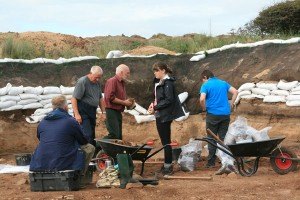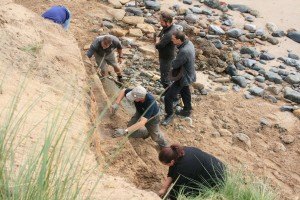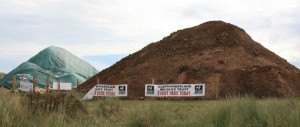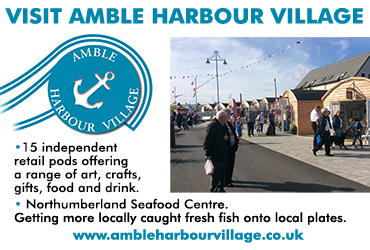Hauxley archaeology: links to the past
Thirteen weeks of digging, scraping, brushing and sifting have come to an end, as the archaeological dig on the Low Hauxley dunes comes to a close. Six hundred people took part, 20,000 flints were uncovered and the project featured in local and national media.
Hailed as “an extraordinary dig”, the project has taken professional archaeologists and local volunteers on a journey back to the time when Britain was still physically connected to Europe. Experts believe that around 8200 BC, a tsunami event occurred, bringing with it a massive and destructive sandstorm which fell over our coastline and which also heralded the process of separation of Britain from the continent.
“It’s been quite an extraordinary dig,” said Clive Waddington, lead archaeologist and project manager of the Rescued From the Sea dig. “Partly because there’s been such a huge local interest and partly because the Amble community and the area around Amble have got so stuck into this project, which is quite amazing. And even with archaeology nationally, it’s very rare, very rare indeed to have such a project that has so many people actively involved.”
Six hundred people were involved in the dig, 20,000 flints have been unearthed, as well as bones, burial pottery and antlers from ancient red deer. Traces of ancient food remains have been found, as well as pots and whetstones from the Bronze Age. Iron Age and Roman pottery was also uncovered, and a wonderfully delicate bone pin.
During the summer-long dig, valuable evidence emerged of the long line of ancient people who lived along this part of the North East coast. What we know and love as wild and rugged Northumbrian dunes, was not always the landscape our ancestors knew. The sea was further away than it is now, but it would have been visible to the people building a patio in Roman times, burying their dead in the Bronze Age, and further back still, to Mesolithic hunter gatherers who built their homes here ten thousand years ago, when the area was swamp and forest.
Digging into the Mesolithic soil layer, the team realised they had a unique opportunity to delve further into the past. The Heritage Lottery Fund granted an additional three weeks of funding to allow pre tsunami level excavations to take place.
Huge boulders believed to have been thrown onto the land by the tsunami were found, as well as evidence of dwelling huts and more of the ubiquitous flints were uncovered.
The dig was carried out by a team of professional and student archaeologists from Archaeological Research Services and Newcastle University as well as a hardy band of local volunteers – schoolchildren to octagenarians, all fascinated by the story they were uncovering. Even passers-by were drawn to the site:
“Every time I’ve visited the site, there are at least 20 -30 people; they either arrive on bikes, or walk up, and just see [the dig] and they’re interested. ” said Steve Lowe, Head of Conservation at Northumberland Wildlife Trust, one of the partners organising the dig.
Media interest, like local interest, has been huge. BBC and ITV regional news, as well as national interest from The One Show, Countryfile and Time Team have all fallen under the spell of the dig on the dunes, and local schoolchildren used the event to learn documentary making.
The last task now is to remove all the plastic and replace the sand and soil piled into huge pyramids alongside the excavation site. Marram grass will be reseeded and the site left as near to what it was as is possible.
But for the archaeologists the work is still ongoing. Sifting, sorting, cataloguing and writing reports is all still to come. And a talk in Amble from Clive Waddington followed by a Time Team special programme will be scheduled for next year.
“The fact that we’ve got this layering of the archaeology, and the archaeology goes back in time so far, so you’ve got from these early hunter gatherers all the way through to the Roman period, that in itself is very unusual. There’s been a coming together of incredibly well preserved remains, this incredibly long sequence of archaeology, and plus the local community interest and you add that together and it’s just made it a real privilege to be involved in this project,” said Clive.
Anna Williams
See also:
Uncovering Bronze Age Hauxley devastated by sandstorm
Tsunami archaeology dig continues at Low Hauxley
















HI,
It’s great to see that the project has been very successful. I think the lottery grant was a great help for the project. I was just wondering how do you apply for this lottery grant?
Matthew
Hi Matthew, I’m not sure if they accessed a specific part of the Heritage Lottery Fund, but you could try this link: http://www.hlf.org.uk/HowToApply/programmes/Pages/HeritageGrants.aspx#.Uk1sSNI-TTo
Clive pays tribute to the interest shown by Amble people, but I think the archaeologists were great. We turned up at the dig on several occasionsand each time one of them came over and spent quarter of an hour telling us what was happening and how things were going.
These things work both ways!